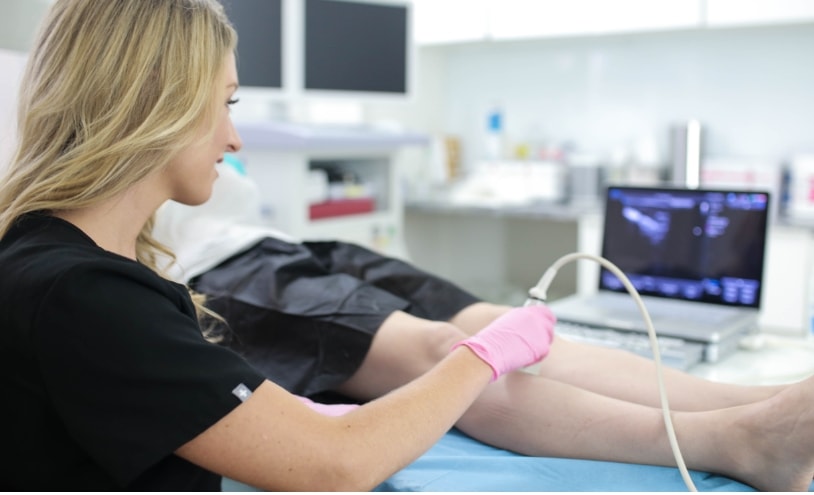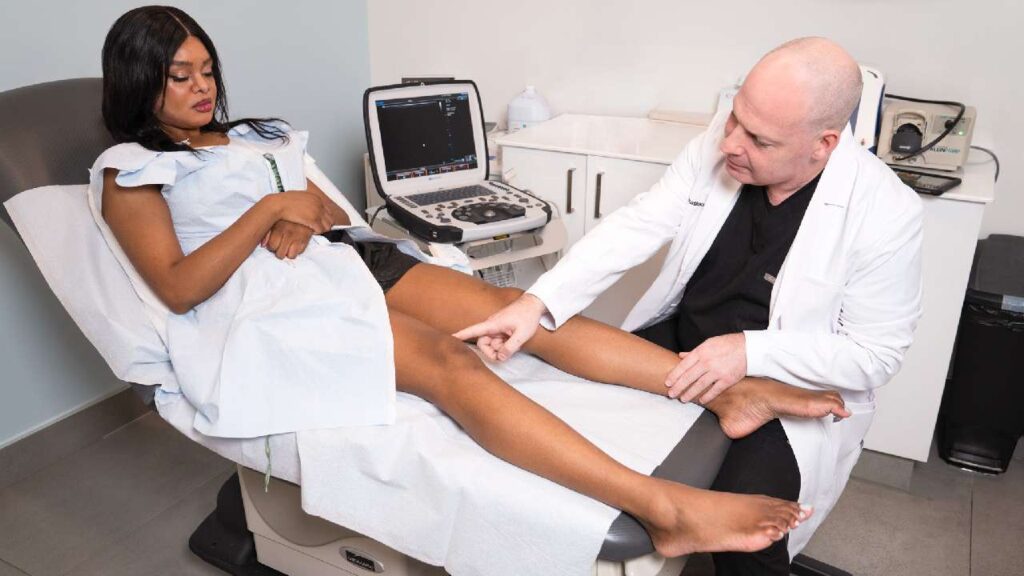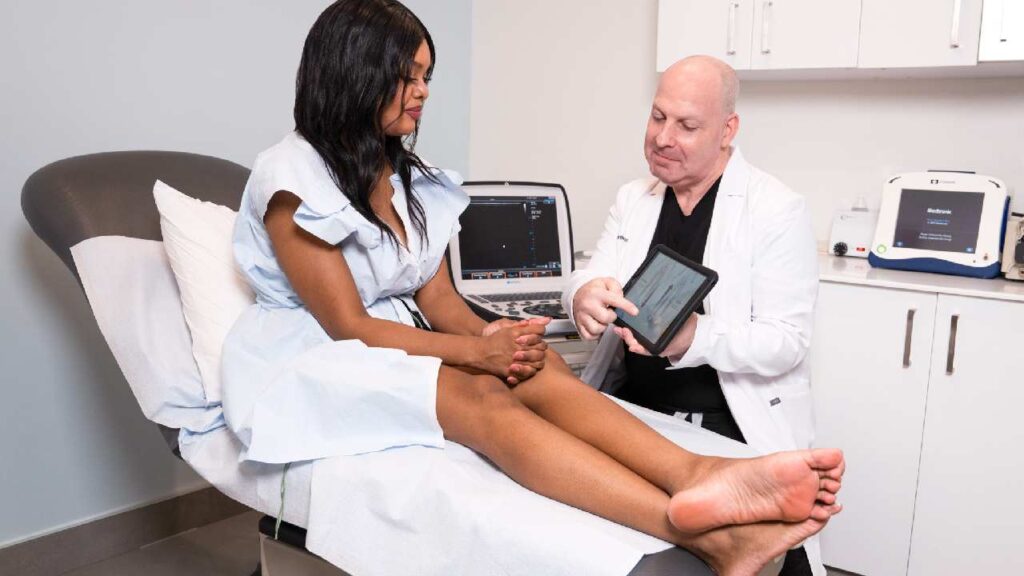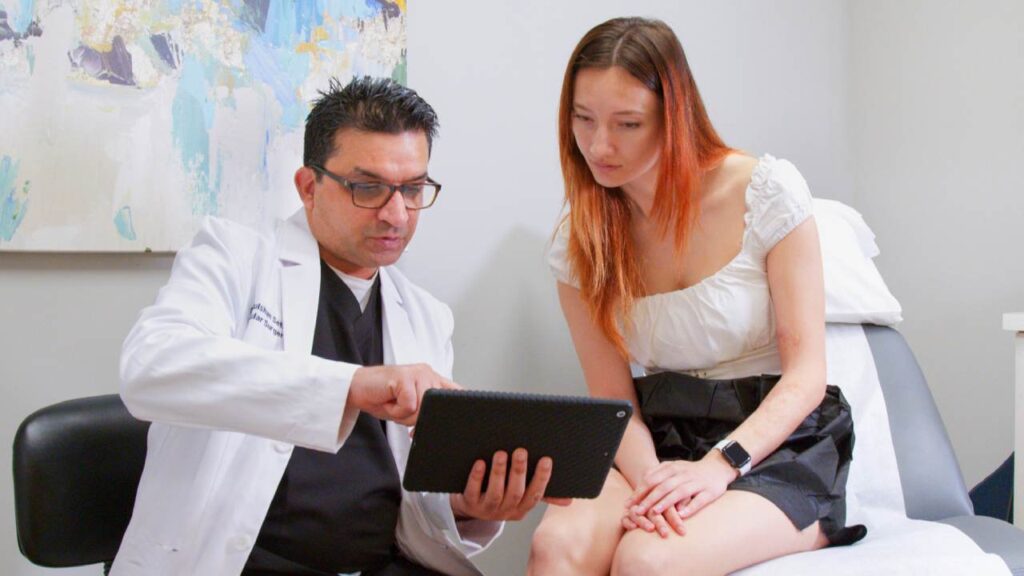What Are the Chronic Venous Insufficiency Stages?
Chronic Venous Insufficiency (CVI) is a common condition in which veins don’t pump blood efficiently. Veins rely on valves to close once blood flows past them, to keep blood moving toward the heart. When vein valves break, or when vein walls stretch such that valves can’t close tightly, blood flows in reverse. This causes a host of painful symptoms. Book an appointment with our Harvard-trained vein doctors to treat CVI before it progresses to an advanced stage.
Our vein doctors use the CEAP (clinical, etiology, anatomy, pathophysiology) classification system to determine which stage of CVI patients are in. Clinical assessments examine how the disease impacts your body. Etiological assessments determine the disease’s origination. Anatomical assessments identify which blood vessels are affected. Pathophysiological assessments examine the impact on blood flow. Our vein specialists conduct physical exams and use lab tests and ultrasonography to analyze your health from all four CEAP perspectives. Here’s how CVI looks, from a clinical standpoint, at each stage.
Clinical Stages of Chronic Venous Insufficiency:
Stage 0: Disease exists but there are no discernible symptoms
Stage 1: Formation of spider veins or reticular veins
Stage 2: Development or recurrence of varicose veins
Stage 3: Swelling in legs and ankles
Stage 4: Skin issues like venous stasis dermatitis and hyperpigmentation
Stage 5: Venous ulcerations that are healing
Stage 6: Open or recurrent ulcerations that aren’t healing
After identifying clinical chronic venous insufficiency stages, vein doctors look at the etiological, anatomical, and pathophysiological aspects of venous diseases. What caused it? Which veins need treatment? Which treatment will optimize circulation? Our team has many treatment options, and we often combine methods for customized care.
In addition to visible symptoms like swelling, hyperpigmentation, varicose veins, spider veins, venous ulcers, and venous stasis dermatitis, patients also contend with invisible CVI symptoms. These include heaviness, pain, cramping, itching, and restlessness in the legs. Our doctors relieve these symptoms too, to restore your comfort along with your skin’s appearance.

How Do You Get Venous Insufficiency in Your Legs?
Venous insufficiency has several causes. Some are more preventable than others. The primary risk factor for CVI is a family history of venous disease. Sex is also a factor. CVI occurs in more women than men. Hormone fluctuations from pregnancy, hormone replacement therapy, birth control usage, and menopause elevate blood pressure and stretch veins. Obesity increases pressure on veins. Having a sedentary job worsens CVI. Aging influences CVI since veins weaken over time.
How Do I Choose What Doctor to See for Venous Insufficiency?
Cosmetic vein specialists don’t treat CVI. They use surface treatments for issues like broken capillaries, which often result from sun damage or skin injury, not CVI. Spider veins and varicose veins in the legs are usually caused by venous insufficiency. Choose a board certified vein doctor for leg veins. Vein specialists identify and treat CVI in deep veins, not just the damage in superficial veins.
Select a doctor who studied vein medicine, vein imaging, or vascular surgery, and who specializes in minimally invasive vein treatments. Make sure they’re trained in ultrasound-guided procedures since these are often needed for CVI treatment. Our award-winning vein doctors hold multiple board certifications, and we offer all of the latest minimally invasive treatments.
What Are the Common Femoral Vein Reflux Treatment Methods?
There are several ways to treat venous reflux if the doctor is equipped. Our New York vein clinics are accredited by the Intersocietal Accreditation Commission. This rare distinction means we have superior treatment devices and success rates. Our vein experts have exceptional track records with CVI. Here are some minimally invasive vein treatments we use.
- Sclerotherapy
- Mechanochemical Ablation
- Radiofrequency Ablation
- Endovenous Laser Treatment
- Vein Adhesives
Why Do Doctors Collapse Veins That Have CVI?
To prevent venous insufficiency, doctors must collapse veins that don’t work correctly. When blood retreats through a vein, pressure builds. That causes veins to bulge and contort, or become varicose. It also causes new blood vessels to spread out from the overburdened vein. These are spider veins.
Spider veins are dead ends. If you look at them, you can see that they don’t lead back to the heart, which is where veins are supposed to carry blood. Varicose veins are too engorged to efficiently pump blood, so they’re also useless to your circulation. The human body has miles of blood vessels, and it doesn’t need damaged veins. Doctors collapse veins with valve failure and redirect blood into healthy veins.
Does Collapsed Vein Treatment Help with CVI Management?
Treating collapsed veins and valve failure in deep veins is essential to CVI management. If you seek vein treatment from a cosmetic vein clinic, they won’t address this underlying issue. So, new spider veins and varicose veins will develop. Patients often think their spider vein or varicose vein has returned after treatment. In most cases, patients are seeing new veins form in the same area, because they received superficial vein treatment that didn’t treat CVI. Choose qualified vein doctors, so you don’t waste time and money on cosmetic vein treatments.
How Do You Treat Venous Stasis Dermatitis or CVI Ulcers?
Another reason to treat CVI is that it produces uncomfortable issues like venous stasis dermatitis and venous ulcerations that are slow to heal. Doctors can provide topical treatments for short-term relief of these problems. But the key to eliminating these conditions is treating the venous insufficiency. These skin problems will likely persist until circulation is improved. Venous ulcers can cause serious infections. If you develop a fever, red streaks, or oozing, go to the emergency room.
Is Venous Stasis Surgery Necessary?
Surgery is rarely required for venous stasis. Doctors treat veins with tiny devices they insert through the skin, guided by ultrasound technology. They don’t need to surgically extract most veins. Instead, they collapse veins so they’re removed from circulation. However, patients with blood clots or severe tortuosity might require surgery if it’s unsafe to insert devices in these veins.
What Are the Mayo Clinic Varicose Vein Treatment Suggestions?
What do medical experts from Harvard Health and Mayo Clinic recommend for CVI? The top vein specialists agree that surgery is no longer the first line of treatment for veins in 2023. Minimally invasive vein treatments have largely replaced surgery. Treating veins non-surgically is safer, gentler, quicker, and more affordable for most patients. It presents less risk of recurrence, since veins can grow back after being cut, but not after being sealed.
How Can I Prevent Future Venous Complications?
To prevent future venous complications, consult your vein doctor. They might suggest exercise, weight loss, or elevating your legs while resting. But this depends on your unique health. Our team uses tests like vein mapping to locate issues in your vasculature. This helps prevent problems before they arise. Book a consultation at our vein clinics in New York to protect your vascular health.





